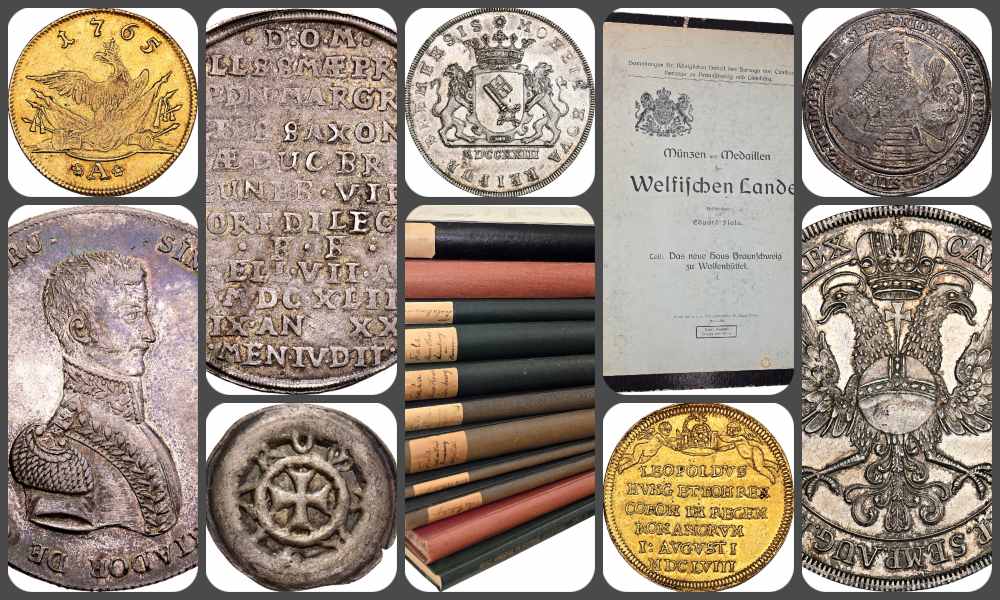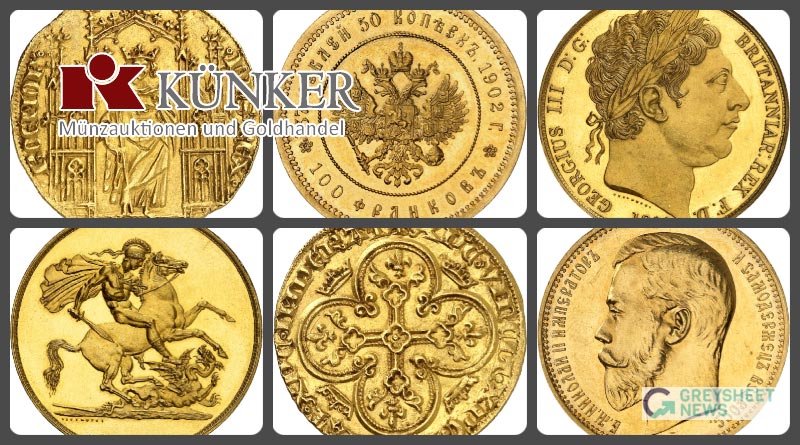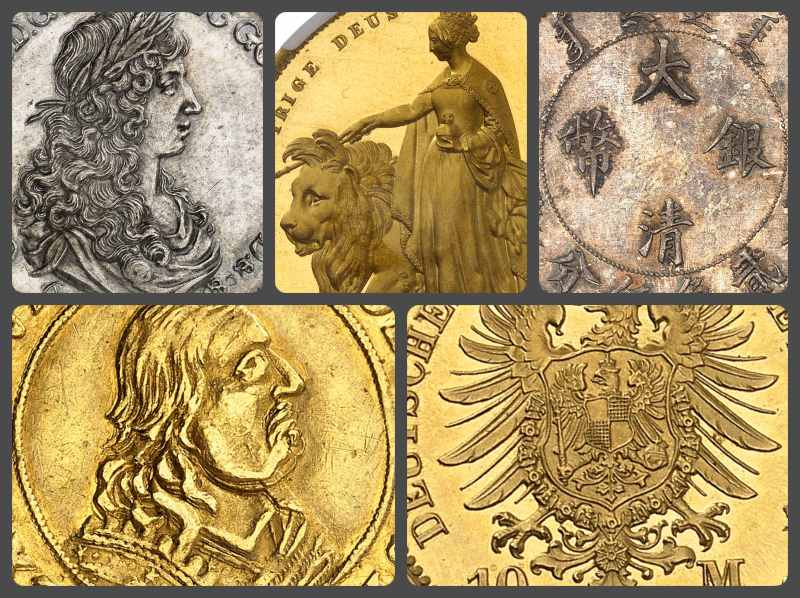Realizing Nearly $10m Euros Here are The Top Results of Künker's Berlin Auction Sales
A total result of almost 10m euros for 730 lots, 15 six-digit hammer prices, the leading piece selling for 420,000 euros – that is the roundup of Künker’s Berlin Auction Sales.
On 2 February 2023, Künker’s Berlin Auction Sales finally took place again in the context of the World Money Fair in Berlin. The entire team was delighted to be able to meet their customers in person. It was an auction sale like those in the good old pre-Covid days – with a room that was crowded with more than 150 on-site bidders so that you really had to look for it if you wanted to spot an empty seat.
The result was correspondingly impressive. For the 730 lots estimated at 6m euros that were auctioned off on 2 February 2023, Künker realized a total result of almost 10m euros. Particularly remarkable were all the hammer prices in the five- and six-figure range. 15 lots were sold for six-digit sums alone!
This auction review presents the three most expensive lots from catalog 379 with another part of the Salton Collection, as well as the five most expensive lots from auction 380. It is rounded off by a glance at Künker’s eLive Premium Auction 381. The Dr. Eberhard Werther Collection contained coins with estimates and hammer prices in the three-digit range. The fact that the prices of these specimens rose considerably, too, and collectors appreciated quality, rarity and historical importance is illustrated by the three most expensive lots of the Werther Collection.
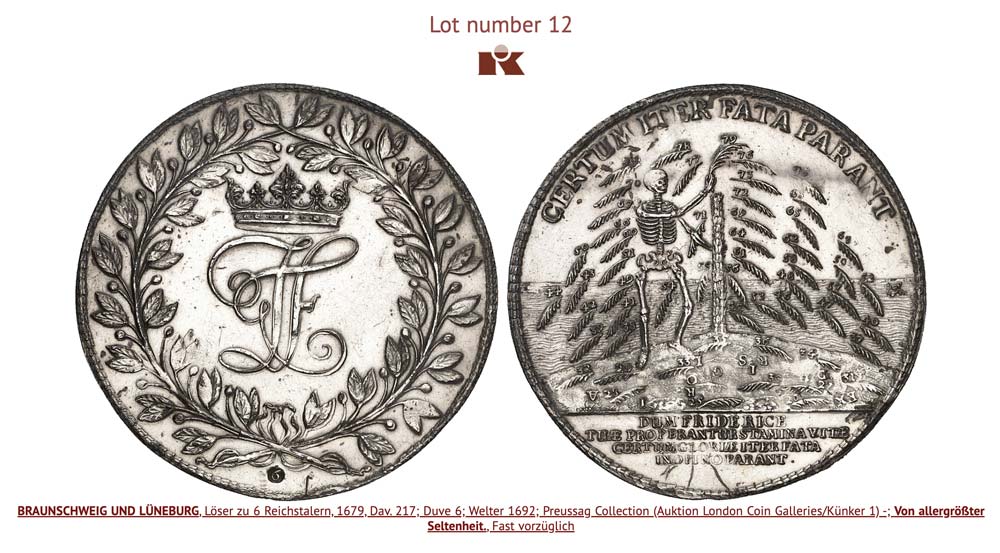
The Most Expensive Coins from Künker’s Auction 379: The Salton Collection
Künker’s Auction 379 with another part of the Salton Collection contained exactly 100 coins. They had an estimate of 625,000 euros and were sold for more than twice that amount: 1.35m euros. These are the three most expensive coins of the auction:
((01 – No. 12: Brunswick-Calenberg-Hanover. John Frederick, 1665-1679. Löser of 6 reichstalers 1679, Zellerfeld. Minted and distributed on the occasion of John Frederick’s funeral. From the Salton and Meyerhof Collections, Schulman auction 171 (1930), No. 156. Extremely rare. About extremely fine. Estimate: 40,000 euros. Hammer price: 75,000 euros.))
3rd Place
In third place we have an extremely rare Brunswick löser with an estimate of 40,000 euros that realized a hammer price of 75,000 euros. The coin was minted as a diplomatic gift to be given to one of the mourners at John Frederick of Brunswick-Calenberg’s funeral on 21 April 1680. We know this because his successor Ernest Augustus had an extensive and lavishly illustrated book published that recorded every detail of this funeral. It also depicts the coins that were given to the mourners. Gottfried Wilhelm Leibniz was probably involved in the design of the reverse motif. He also made important contributions to the iconography of the festive architecture that was built for the funeral procession.
((02 – No. 100: Bohemia and Moravia. Wenceslaus IV, 1378-1419. Prague groschen n.d., Prague. Broad version of 15 Prague groschen. From the Salton and Donebauer Collections, Hess auction (1889), No. 850 and the Wunderly von Muralt Collection, L+L Hamburger auction (1899), No. 61. Extremely rare. Very fine to extremely fine. Estimate: 10,000 euros. Hammer price: 80,000 euros.))
2nd Place
The second most expensive piece of the Salton Collection is from Prague. It is a broad specimen struck with the dies of the Prague groschen that has a weight of 34.10 g. So the coin equaled 15 Prague groschen. This great rarity was estimated at 10,000 euros. The bidders determined its current market value: 80,000 euros.
The provenance of the broad specimen can be traced back to 1889. At the time, the Frankfurt coin shop Hess sold it as part of the Donebauer Collection. The coin entered the market a second time when L+L Hamburger offered it in 1899 as part of the Wunderly von Muralt Collection. Therefore, this object has not one but two connections to the Hamburger-Schlessinger coin dealer dynasty: The former name of Mark Salton, whose collection was on offer, had been Max Schlessinger and his father Felix had worked in Frankfurt at the Hamburger coin shop for many years. He would have inherited it if the hyperinflation following World War I had not nearly bankrupted them.
((03 – No. 56: Wallenstein. Albrecht, 1623-1634, Duke of Friedland. Double reichstaler 1627, Jitschin. From the Salton Collection. Extremely rare. Very fine +. Estimate: 30,000 euros. Hammer price: 95,000 euros.))
1st Place
The most expensive piece of this part of the Salton Collection was also minted in the area of today’s Czech Republic and illustrates the strength of the market for coins that can be associated to the history of this country. The coin bears the name and the portrait of Albrecht von Wallenstein as Duke of Friedland. The double 1627 reichstaler had an estimate of 30,000 and was sold for 95,000 euros. We probably do not need to say anything about Wallenstein, nor about the fact that his character – that must have resembled rather that of an entrepreneur of our age than that of an early modern prince – continues to fascinate people to this day.
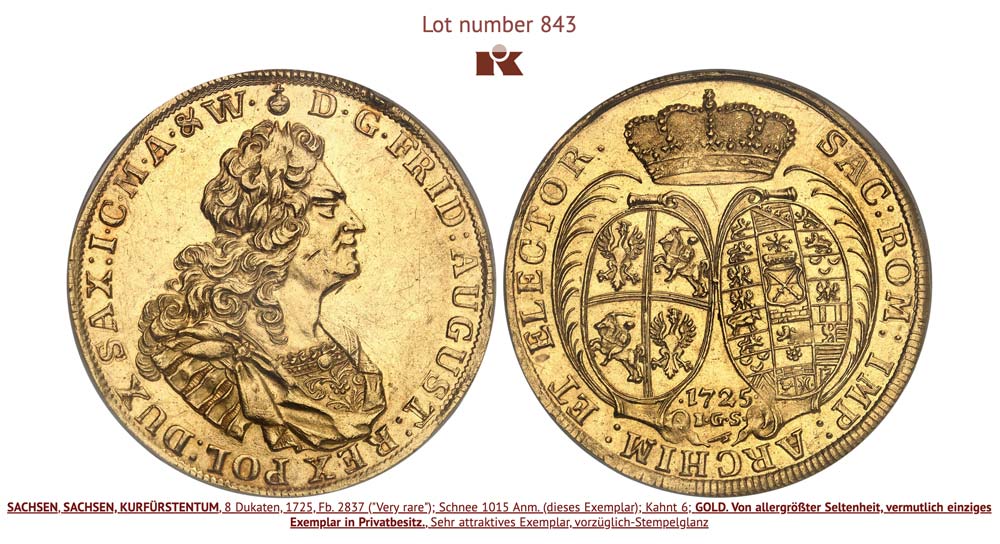
The Most Expensive Coins of Auction 380
Let us go on to auction 380 that offered spectacular individual pieces but also contained the Widegren Collection, one of the most important collections of Swedish coins that have entered the market in recent years. The total estimate of auction 380 was 5.4m euros. The final result amounted to 8.4m euros.
((04 – No. 843: Saxony. Frederick Augustus I, 1694-1733. 8 ducats 1725, Dresden. From the Dr. Friedrich Collection, Hess auction (1914), No. 1127. NGC MS 62+. Extremely rare. Extremely fine to FDC. Estimate: 100,000 euros. Hammer price: 150,000 euros.))
5th Place
Let us begin with a Saxon rarity, an eightfold ducat by Augustus the Strong, which is probably the only specimen in private hands. The combination of great rarity, a provenance that goes far back and outstanding quality – namely extremely fine to FDC or rather NGC MS62+ – proved to be highly tempting to collectors. The coin jumped from an estimate of 100,000 euros to a hammer price of 150,000, making it the fifth most expensive piece of catalog 380.
((05 – No. 340: Sweden. Eric XIV, 1560-1568. Gold gulden 1568, Stockholm. From the Widegren Collection. Extremely rare. Small hole. Very fine to extremely fine. Estimate: 50,000 euros. Hammer price: 200,000 euros.))
4th Place
The fourth most expensive coins is from the Widegren Collection of Swedish specimens. It is a rarity of the highest order and, at the same time, of utmost historical and numismatic importance. After all, it is the first regular gold coin that Sweden ever minted. It is a numismatic enigma why Eric XIV had this gold coin minted. He might have wanted to buy the loyalty of the nobles to prevent them from backing his rebelling brothers. If that was the case, the coins did not arrive in time. Eric received them just a few days before his brother imprisoned him. Therefore, most of his gold coins were melted down again. Only three specimens this type are available on the market today.
The small hole above the king’s head is old. Valuable coins like this one were often worn on heavy necklaces as a sign of loyalty. The buyer considered the fascinating history of this coin, whose provenance can be tracked back to 1899, to be worth 200,000 euros, exactly four times its estimate of 50,000 euros.
((06 – No. 630: Austria / Austrian princes / Schlick. Stephan, Burian, Heinrich, Hieronymus and Lorenz, 1505-1532. Broad triple taler 1520, Joachimsthal. Extremely rare. Very fine. Estimate: 100,000 euros. Hammer price: 220,000 euros.))
3rd Place
Another historical rarity of the highest order, this time from Bohemia, is the broad triple taler of 1520 from Joachimsthal. It recalls one of the largest coin issues of the early modern period. Together with the Schlick noble family, Saxon investors exploited the silver mines in Joachimstal, located on Bohemian soil opposite Annaberg. The ruler of this territory was Ludwig II, not only of Hungary but also of Bohemia and Croatia. He was chronically cash-strapped and accordingly pleased with the investors who gave him a generous share of their profits for the treasury. To make things easier for his customs authority, they agreed that all the silver that was intended to be sold on the silver market in Leipzig was to be minted into coins first. That is the reason why so many Joachimsthal guldiners were minted that the merchants no longer wrote down the coin’s full name but abbreviated it to “taler”.
The triple taler that Künker offered as lot No. 630 was certainly not one of these standard specimens that were used as small ingots for export purposes. It is likely that it was supposed to be a gift, perhaps commissioned by the Schlick family. It is of utmost rarity, and many collectors realized this. Therefore, the hammer only fell at 220,000 euros for this piece estimated at 100,000 euros. This made it the third most expensive coin in the auction sale.
((07 – No. 835: Saxony. Christian II, Johan Georg I and Augustus, 1591-1611. 10 ducats 1611, Dresden. Commemorating the death of Christian II. From MMAG auction 7 (1948), No. 130. Extremely rare. NGC MS65. About FDC. Estimate: 250,000 euros. Hammer price: 340,000 euros.))
2nd Place
340,000 euros were realized by a tenfold ducat from Saxony that had been estimated at 250,000, making it the second-highest result of the entire sale. It was minted on the occasion of the funeral of Christian II of Saxony and depicts Christian II of Saxony on the obverse, probably in his showpiece armor, which played a role in the funerary rite and which has been preserved to this day.
The tenfold ducat was surely given as a diplomatic gift to a high dignitary and probably fetched such a high price because its quality is extremely rare for a coin of the early 17th century. NGC graded the piece MS65 and awarded a star to its unusual beauty.
https://marjorie-wiki.de/wiki/Prunkgarnitur_Christian_II.von_Sachsen
((08 – No. 288: Great Britain. Victoria, 1837-1901. 5 pounds 1839, London. “Una and the Lion”. NGC PF63 CAMEO (Top Pop). Very rare. Proof. Estimate: 100,000 euros. Hammer price: 420,000 euros.))
1st Place
Let us present the most expensive coin of the sale: Una and the Lion. This coin type has become one of the most popular pieces on the international coin trade in recent years. The youthful beauty of Queen Victoria and the allusion to an epic that glorified the unforgettable Elizabeth I were combined by the engraver William Wyon, who created a coin design that enchants people from all over the world. Künker was able to offer one of these pieces at an estimate of 100,000 euros. It was sold for 420,000 euros.
The reason for the high result is its magnificent quality. NGC graded the coin PF63 CAMEO. Moreover, the specimen is a very rare coin type. By now, the English authors Wilson and Rasmussen have divided the different “Unas” into several types. The “Una” offered at Künker is of the type that is defined by its smooth edge and the eleven leaves on the upper hairband. With probably less than five minted specimens, this is the rarest variety that was issued of this popular piece.
The Most Expensive Coins of Auction 381
After all these expensive pieces, it does a bit of good to take a look at coins that more people than just a tiny minority can afford. After all, one thing is for sure: the enjoyment you get out of a coin is the same regardless of whether you spent 10, 10,000 or 10 million euros on it.
The hammer prices that were achieved in eLive Premium Auction 381 are also quite impressive when compared to their estimates. The offered Werther Collection estimated at 105,000 euros realized a total result of 242,000 euros – almost two and a half times as much!
Here are the three most expensive coins from eLive Premium Auction 381:
((09 – No. 1058: Prussia. Frederick II, 1740-1786. Double Friedrichs d’or 1765 A. Very rare. Very fine. Estimate: 3,000 euros. Hammer price: 4,900 euros.))
3rd Place
The third most expensive coin is a classic: the double Friedrichs d’or, minted on behalf of the great Prussian king in 1765 in Berlin. In 1765, only a few double Friedrichs d’ors were minted, which is why the coin climbed from an estimate of 3,000 euros to a hammer price of 4,900 euros.
((10 – No. 1299: Saxony. Frederick Augustus I, 1694-1733. Silver medal 1699 by M. H. Omeis recalling him being a descendant of Duke Widukind. Estimate: 500 euros. Hammer price: 6,000 euros.))
2nd Place
The second most expensive coin of the auction demonstrates how much the combination of rarity and exquisite quality is appreciated – also and especially among collectors. Every well-versed coin expert saw at first glance that the medal of Augustus the Strong, which addresses his descent from the Saxon Duke Widukind, was of utmost perfection. Untouched, with a beautiful patina, this medal is the epitome of a showpiece. And this was reflected by the price. The estimate was 500 euros. The bidding war did not end until the impressive sum of 6,000 euros was reached, making the piece the second most expensive coin of this auction.
((11 – No. 1226: Frankfurt. Double ducat 1658 in celebration of the coronation of Leopold I as Holy Roman Emperor in Frankfurt. Very rare. About extremely fine. Estimate: 3,000 euros. Hammer price: 6,750 euros.))
1st Place
Let us round off this auction review with the most expensive coin from eLive Premium Auction 381. It was – just like the double Friedrichs d’or of 1765 – estimated at 3,000 euros. However, the slightly bent, about extremely fine coin is very rare. It is a Frankfurt double ducat of 1658 minted on the occasion of the coronation of Leopold I as Holy Roman Emperor. A collector considered this worth a bid of 6,750 euros. The collector might have known that the coin type he purchased is depicted on a copper engraving by Matthäus Merian, namely one that features the festivities of the coronation in great detail and also shows how coins are thrown among the people. If you do not believe this, take a look at volume 8 of Theatrum Europaeum.
You see: coin collecting is a rewarding hobby for everyone! Every coin is more than just an investment object – it is a wonderful point of departure that invites us to take historical strolls of any kind.
Künker, Nobbenburger Straße 4a, 49076 Osnabrück, Germany; phone: +49 541 / 962020; fax: +49 541 / 9620222; or via e-mail: service@kuenker.de. You can find the auction results online at www.kuenker.de.

Download the Greysheet app for access to pricing, news, events and your subscriptions.
Subscribe Now.
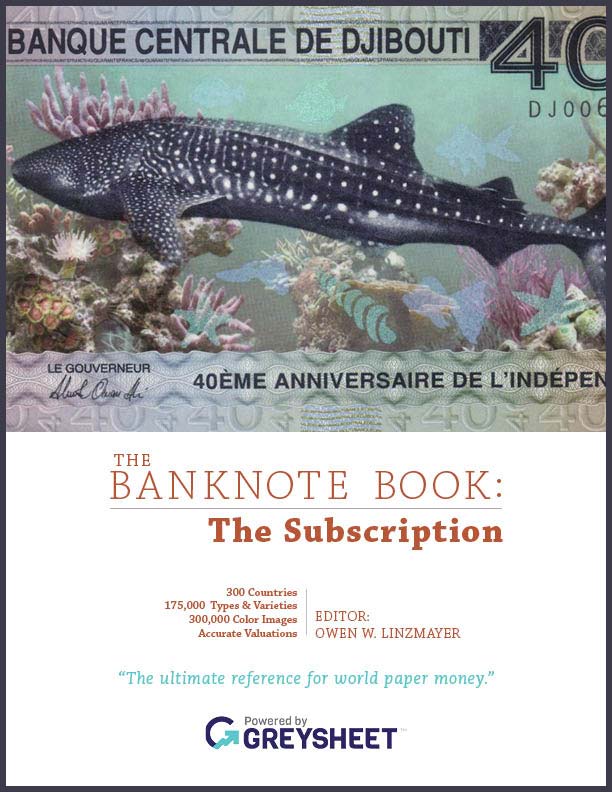
Subscribe to The Banknote Book for the industry's most respected pricing and to read more articles just like this.
Source: Fritz Rudolf Kuenker GmbH and Co. KG


